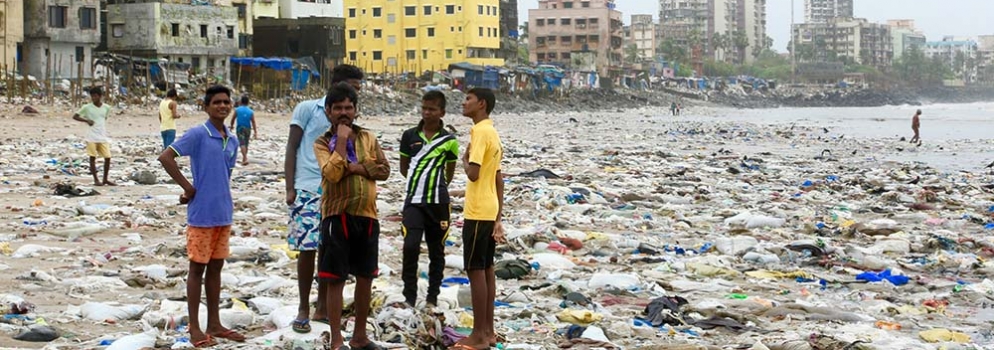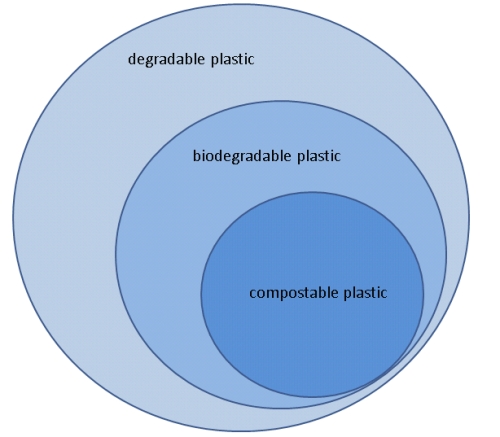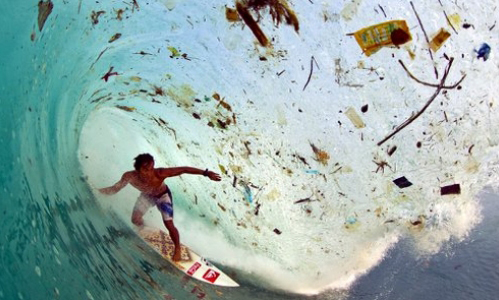Given mounting pressures outlined in Part 2, the plastic manufacturing industry is likely to share the responsibility for ocean plastic pollution. Of course this is a complex topic with multiple players but let’s consider addressing our current “plastics problem” from a plastic manufacturer’s perspective, since as an industry they have the biggest impact.
1. Start by getting the public involved; help collect ocean plastic from the most heavily polluted areas.

UN Declares War on Ocean Plastic Photo Credit: UNEP.org
2. Plastic manufacturers could then purchase and use that recycled plastic in their product lines (bonus: reduce shipping fees by not having to export plastic waste to remote countries).
Adidas is already doing it
Photo Credit: www.highsnobiety.com
Revenue (and marketing) opportunity: Recycled Plastic = lower cost of goods compared to virgin plastic.
Take it a step further by also using recycled plastics from commonly disposed plastics:
- Polyethylene Terephthalate (PET or PETE) – Plastic #1 used for disposable food and drink containers including water, soda and cooking oil bottles
- Polypropylene (PP) – Plastic #5 with a high resistance to heat. It is used for drinking straws, caps and containers
You may be familiar with common issues with recycled plastics:
While recycled plastics might not have the same strength and colour as virgin plastics, plastic manufacturers should explore avenues such as nanotechnology to improve recycling technologies (listen to Mike Biddle’s TED TALK) or use it for products that do not require extended lifespans.
Most noteworthy points from this talk:
- Plastic is actually more valuable than steel, but more difficult to sort and recycle
- Typically, cheap labour is used to manually sorted plastic using ‘burn & sniff’ technique
- Walk through of how recycle plastics are transformed into new products, at the same strength as the original plastic
- He has moved his factories to Europe and China to get better access to recycled source material
I’m sure there are limitations such as huge infrastructure investments, but have any plastic manufacturers bought recycled plastics from Mike Biddle/MBA?
For instance, Mike Biddle/MBA looks like they receive raw material from Canada’s own Plastic Bank, which acts as a plastic collection network:
What I love about Plastic Bank’s model is that they are associating plastic waste with value; a currency.
Revenue opportunity: Plastic Bank for instance, pays people who help collect the material (they receive a percentage of the revenue earned from the sale of MBA processed recycled plastic).
//www.youtube.com/watch?v=SdLQLaZO10U
It reminds me of the scheme we have in Ontario where we get a few cents every time we return glass beer bottles. According to a 2010 report, Beer Store’s recycling rate is 92%!
Revenue opportunity: it seems like we really could create a recycled plastic marketplace, connecting plastic collectors looking to make money with plastic recycling manufacturers looking to use recycled plastic in their supply chain.
FURTHER STEPS THAT SHOULD BE TAKEN TO CURB OUR APPETITE
3. Plastics should be priced based on lifespan. You should have to pay more for something longer (i.e. PVC pipes, underwater storage tanks) lasting versus something you need for one day (i.e. disposable cutlery).

The difference between degradable biodegradable and compostable. Photo Credit: //green-plastics.net
Back to 1. Lets improve awareness surrounding disposable plastics

Do you know where your frozen seafood is sourced from ? Photo Credit: //www.adidas.com/us/parley
Once school kids are made aware, they are likely to be part of the change, get grandparents and parents involved.
My favourite inspiration of this model is from Pune, India, where a non-profit successfully encouraged school kids to then go home and collect disposable plastic from their own homes and bring it to school daily.
Revenue opportunity: The school then became a collection point where a local recycle plastic manufacturer would collect already sorted plastic and make a payment to the school’s green fund.

How Thousands of Children in Pune Prevented Over 50 Tonnes of Plastic from Reaching the Sea Photo Credit: thebetterindia.com
I love this model cause it provides generational awareness to help curb our plastic consumption and financially motivation to reduce existing ocean plastic waste. Imagine if we did this in our schools …
Inspired? Please share this to encourage awareness & let’s get started!
